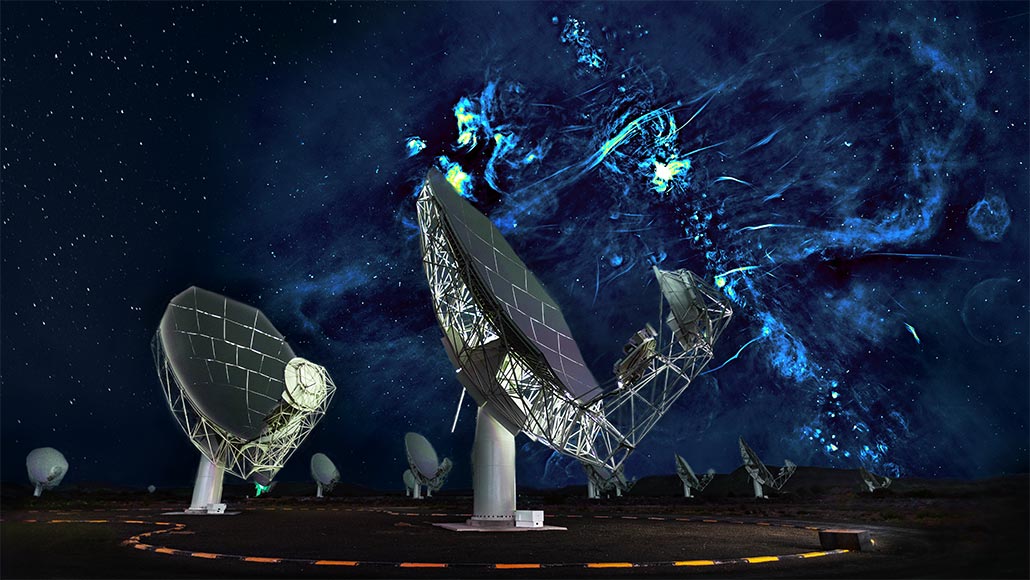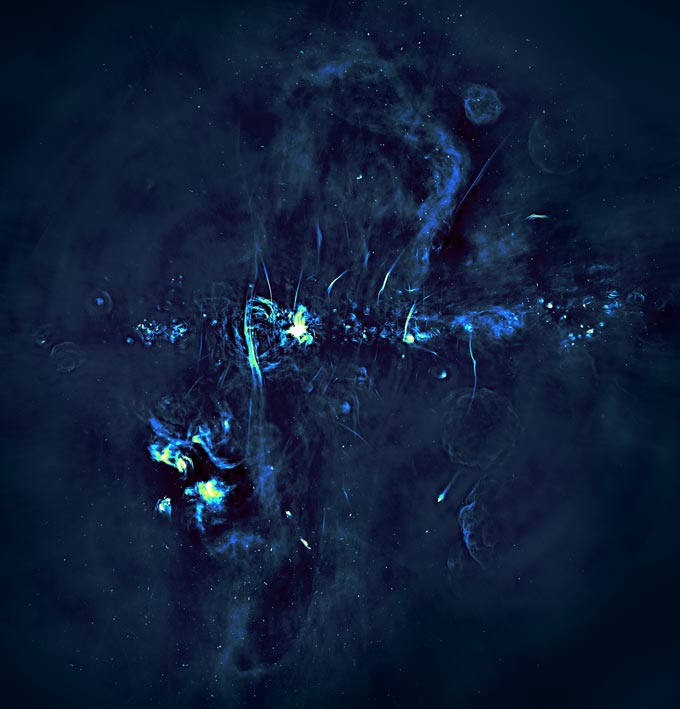Giant radio bubbles spew from near the Milky Way’s central black hole
Newfound structures hint at a violent past for the galaxy’s heart

The MeerKAT telescope array (pictured) spotted two enormous radio bubbles emerging from the center of the Milky Way (seen overlaying the night sky in this composite image). The bubbles are faint structures that extend to the upper right and lower left.
SARAO, Univ. of Oxford
- More than 2 years ago
Discoveries keep bubbling up at the center of the Milky Way.
Colossal bubbles emanate from this spot, spitting out radio waves detected with the help of a new telescope. The structures are a sign of a long-ago burst of activity from the region around the now relatively sleepy supermassive black hole at the galaxy’s center, researchers report in the Sept. 12 Nature.
An image of the ethereal bubbles showcases the capabilities of the South African Radio Astronomy Observatory’s MeerKAT radio telescope, an array of 64 dishes spread out over a region eight kilometers across near Carnarvon. The completed telescope began taking data in spring 2018.
These radio wave–emitting bubbles extend hundreds of light-years above and below the plane of the Milky Way. And they point to “something extraordinary that had happened in the galactic center,” says astrophysicist Ian Heywood of the University of Oxford.

Heywood and colleagues estimate that an event involving vast amounts of energy — equivalent to the explosion of approximately 100 stars — sent matter spewing out of the region around the black hole a few million years ago. Speedy, electrically charged particles produced in that event, accelerated by magnetic fields, create the bubbles’ radio waves, the team suggests.
A temporary black hole feeding frenzy long ago could have spawned the bubbles, as the behemoth gulped down matter and spewed the excess outward. Or the bubbles might be the result of a mob of stars forming around the black hole. Those stars could have eventually exploded in supernovas, expelling their innards.
The bubbles are brighter along their edges, suggesting that a shock wave of material is plowing outward, the researchers found. That means that whatever produced the bubbles wasn’t an ongoing process, but one that switched on after a period of calm.
These radio bubbles are “one piece of the mosaic” at the center of the galaxy, says astrophysicist Jun-Hui Zhao of the Harvard-Smithsonian Center for Astrophysics in Cambridge, Mass., who was not involved in the discovery. In March, astronomers reported chimneys of X-rays that spew from the galaxy’s heart (SN: 3/20/19). These chimneys overlap with the newly spotted radio structures, suggesting a common origin. And earlier observations revealed enormous gamma-ray bubbles, much larger than the X-ray and radio structures, that balloon from either side of the galaxy (SN: 11/9/10).
Glimpsing new pieces of the mosaic, such as the radio bubbles, could help scientists determine the origins of some of those previously uncovered oddities. For example, the bubbles envelop a set of mysterious structures known as radio filaments, tall, thin streaks discovered in the 1980s. Although it’s still unclear how the filaments form, the new result links them to the radio bubbles.
“This is really the first time you see the clear connection between outflows and the illumination of these filaments,” says astronomer Daniel Wang of the University of Massachusetts Amherst who wasn’t involved in the research. “This is a fantastic image.”







